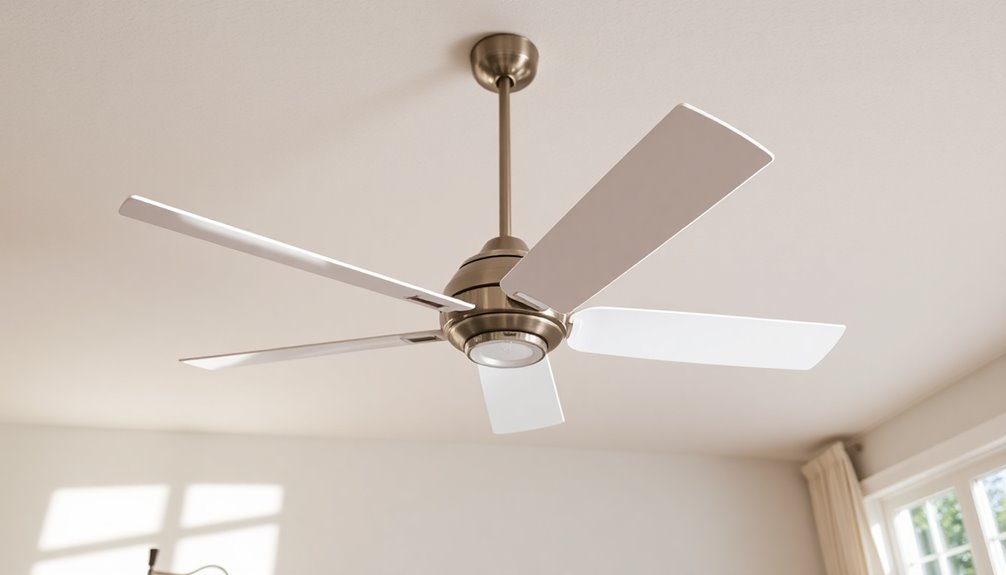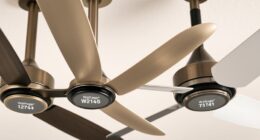Optimizing your ceiling fan for summer is crucial for staying cool efficiently. Set the rotation counterclockwise to enjoy a refreshing breeze and save on energy costs. Ensuring proper blade height for optimal air circulation is key, along with clearing at least 10 inches between blades and the ceiling for efficient airflow. Vaulted ceilings benefit from counterclockwise rotation, enhancing air circulation by up to 30%. To delve deeper into maximizing your ceiling fan's performance during the summer months, explore ideal clearance, energy-saving tips, and ways to maintain a balance between comfort and efficiency.
Key Takeaways
- Set fan rotation counterclockwise for a cooling breeze.
- Adjust fan height for optimal air circulation.
- Use a flush mount fan for low ceilings.
- Clean and maintain fan blades regularly.
- Enjoy energy savings by running fan at low speed.
Proper Ceiling Fan Height
When optimizing a ceiling fan for summer, the proper height at which it's installed significantly impacts its performance and efficiency. It's crucial to hang the ceiling fan between 7 to 9 feet from the floor to ensure optimal air circulation in the room. This ideal placement allows the fan blades to efficiently move air throughout the space, keeping you cool during the hot summer months.
For vaulted ceilings, using a down rod to hang the fan at the right height is essential for effective cooling. This setup ensures that the airflow is directed downwards, maximizing the fan's cooling capabilities.
In rooms with low ceilings, a flush mount ceiling fan is recommended to maintain proper clearance and ensure efficient operation.
Ideal Ceiling Fan Clearance

When setting up your ceiling fan, it's crucial to ensure proper clearance for optimal performance. Keeping at least 10 inches of space between the fan blades and the ceiling promotes efficient airflow.
Additionally, mounting the fan about 18 inches away from walls prevents air obstruction and ensures the fan operates at its best.
Fan Blade Height
To optimize air circulation and safety, ensuring the ideal ceiling fan clearance of between seven and nine feet from the floor is crucial. Proper fan blade height is essential for efficient airflow and preventing obstructions. Here are key considerations for achieving the right fan blade height:
- Maintain a minimum clearance of 10 inches between the ceiling fan blades and the ceiling.
- Mount the fan at least 18 inches away from any walls to ensure proper air movement.
- Use a down rod when installing the fan on vaulted ceilings to achieve the correct height and improve airflow distribution.
- For low ceilings, consider a flush mount ceiling fan to maintain the recommended distance from the floor and enhance air circulation.
Room Size Compatibility
For optimal air circulation in a room, it's essential to consider the compatibility of the ceiling fan size with the room dimensions. To ensure efficient operation, the ceiling fan should hang between seven and nine feet from the floor.
Maintaining a minimum clearance of 10 inches between the ceiling fan blades and the ceiling is crucial for proper functionality. Positioning the fan at least 18 inches away from walls prevents air obstruction and enhances airflow.
For vaulted ceilings, use a down rod to adjust the fan to the appropriate height. In rooms with low ceilings, a flush mount ceiling fan is ideal to guarantee proper clearance and efficient air circulation.
Vaulted Ceiling Considerations
Considering the unique design of vaulted ceilings, optimizing your ceiling fan's rotation direction can significantly enhance air circulation and cooling efficiency during the summer months. Here are some key considerations for vaulted ceilings:
- Counterclockwise Rotation: Set your ceiling fan to rotate counterclockwise in vaulted ceilings to promote better air circulation and maintain consistent room temperature.
- Cooling Breeze Effect: Running the fan in a counterclockwise direction creates a cooling breeze effect, enhancing comfort in rooms with vaulted ceilings.
- Energy Cost Savings: Properly directing your ceiling fan in vaulted ceilings can help reduce energy costs by up to 30% during the summer months.
- Maximizing Cooling Efficiency: Ensure that the fan blades are set to rotate counterclockwise to maximize cooling efficiency and airflow distribution in rooms with vaulted ceilings.
Low Ceiling Solutions

When addressing low ceiling solutions, ensuring proper clearance and secure installation of a flush mount or hugger ceiling fan is crucial. For ceilings lower than 8 feet, a flush mount fan is ideal to prevent safety hazards. To optimize air circulation, maintain a distance of at least 7 feet between the ceiling fan blades and the ceiling. Secure attachment of the ceiling fan is essential to prevent wobbling or instability.
Low profile ceiling fans are designed specifically for rooms with limited ceiling height, offering efficient air circulation while maintaining safety. By choosing a fan that hugs the ceiling, you can enjoy the benefits of airflow without sacrificing clearance. Whether it's a flush mount or a hugger fan, these options provide practical solutions for low ceilings, ensuring comfort and functionality in your space. Prioritizing proper installation and clearance will help you make the most of your ceiling fan's cooling capabilities.
Summer Fan Rotation

To maximize cooling efficiency during the summer months, adjusting the rotation of your ceiling fan blades to counterclockwise is crucial. This simple adjustment can create a cooling breeze effect in your home and help you feel more comfortable without having to lower the thermostat. Here are some benefits of running your ceiling fan counterclockwise during the summer:
- Air Movement: Counterclockwise rotation pushes air downwards, creating a gentle breeze that can make you feel cooler.
- Wind Chill: Running the fan at high speed in the correct direction can generate a wind chill effect, making the room feel even cooler.
- Energy Savings: By using your ceiling fan in conjunction with your air conditioning and setting it to rotate counterclockwise, you can reduce energy costs by up to 30 percent.
- Cooling Breeze: Increasing the thermostat by 4 degrees while running the fan counterclockwise can still maintain a comfortable temperature in your living space.
Make sure to switch your fan to counterclockwise rotation to enjoy these benefits and stay cool all summer long!
Counterclockwise for Efficiency

Setting your ceiling fan to rotate counterclockwise in the summer enhances cooling efficiency and promotes a comfortable environment. This direction creates a cooling breeze effect in the room, making it feel up to 4 degrees cooler according to Consumer Reports. By following Energy Star's advice to raise the thermostat and use ceiling fans, you can save 3-5% on air conditioning costs for each degree, potentially saving around $110 on power bills as estimated by Hunter Fans. Not only does counterclockwise rotation help maintain a consistent room temperature, but it also reduces the need for constant AC usage, leading to significant energy savings. To emphasize the benefits of setting your fan to rotate counterclockwise, let's look at the table below:
| Benefits of Counterclockwise Rotation |
|---|
| Creates Cooling Breeze Effect |
| Helps Save on Energy Costs |
| Maintains Consistent Room Temperature |
| Enhances Cooling Efficiency |
| Promotes Comfortable Environment |
Room-Specific Fan Direction

Optimizing the ceiling fan direction based on the room's purpose and occupants' activities contributes to a more comfortable and efficient environment during the summer months. Here are some room-specific fan direction tips:
- Bedrooms: Set the fan to rotate counterclockwise for a cooling breeze during summer nights, ensuring a restful sleep.
- Living Rooms: Use a high-speed counterclockwise setting to create a wind chill effect, enhancing comfort for relaxation and gatherings.
- Kitchens: Adjust the fan direction to counterclockwise to reduce cooking heat and maintain a cooler atmosphere while preparing meals.
- Home Offices: Opt for a medium-speed counterclockwise rotation to prevent papers from fluttering and ensure a steady airflow conducive to productivity.
Blade Maintenance Importance

Regularly cleaning and maintaining your ceiling fan blades is essential for keeping your fan running smoothly and efficiently.
Dust and dirt buildup can hinder airflow and decrease performance, but simple cleaning techniques like using a pillowcase or applying car wax can help maintain optimal operation.
Blade Cleaning Tips
Ensuring your ceiling fan blades remain clean is essential for maintaining optimal airflow and efficiency during the summer months. Regular cleaning helps prevent dust buildup, which can impede the fan's performance. Here are some tips to keep your blades in top condition:
- Regular Cleaning: Dust and dirt accumulation can slow down your fan, so clean the blades frequently.
- Use Car Wax: Applying car wax can prevent dust buildup and keep the blades operating smoothly.
- Pillowcase Method: Hunter Fans recommend using a pillowcase to effectively remove dust and debris from the blades.
- Longevity and Efficiency: Properly maintaining and cleaning your fan blades ensures longevity and efficient operation.
Balancing Techniques
After maintaining cleanliness and smooth operation of your ceiling fan blades, it's crucial to address balancing techniques to ensure optimal performance. Properly balanced fan blades prevent wobbling, ensuring efficient air circulation in the desired direction.
Imbalanced blades not only cause noise but also reduce performance, leading to increased energy consumption. Regular blade maintenance, including checking for proper alignment, is essential. Balancing kits are available to help adjust and optimize blade alignment for smooth operation, preventing warm air pockets and promoting energy efficiency.
Remote Control Benefits

Having a remote-controlled ceiling fan enhances convenience by enabling users to adjust fan settings from anywhere within the room. Here are some benefits of having a remote control for your ceiling fan:
- Convenience: Easily change fan speed, direction, and lighting options without having to get up or stretch to reach the fan.
- Programmable Settings: Some remote controls offer programmable settings, allowing you to customize your fan experience to suit your preferences.
- Modern Aesthetic: Remote control fans eliminate the need for pull chains, giving your room a sleek and modern look.
- Enhanced User Experience: Adjust fan settings effortlessly, enhancing your comfort and overall user experience.
Remote control ceiling fans not only provide ease of use but also add a touch of modernity to your space. With programmable settings and the ability to control your fan from anywhere in the room, a remote-controlled ceiling fan is a valuable addition to any home.
Energy Saving Tips

Adjusting your ceiling fan to rotate counterclockwise at a lower speed can help with energy savings during the summer months.
By following this simple tip, you can maximize the cooling effect in your home while reducing your electricity bill.
It's an easy and effective way to stay comfortable and eco-friendly.
Adjust Fan Direction
How can you optimize your ceiling fan for summer to save on energy costs while staying cool? Adjusting your fan direction is key. Here's how:
- Set it Counterclockwise: This creates a cooling breeze effect, making the room feel up to 4 degrees cooler.
- Save on AC Costs: Energy Star estimates you can save 3-5% on AC costs for each degree you raise the thermostat, especially with a counterclockwise fan rotation.
- Lower Power Bills: Hunter Fans suggest using ceiling fans could save you around $110 on summer power bills.
- Enhanced Comfort: Properly adjusting your fan counterclockwise can significantly improve comfort and save energy during the summer months.
Use Lower Speeds
Lowering the speed of your ceiling fan is a practical way to save energy and reduce electricity costs during the summer months. By running the fan at a low speed, you can still enjoy a cool breeze without overcooling the room.
Energy Star suggests using ceiling fans on low to potentially save up to 40% on cooling costs. Adjusting the fan speed based on your comfort levels not only enhances energy efficiency but also ensures you stay comfortable while reducing energy consumption.
Comfort and Efficiency Balance

Striking a harmonious balance between comfort and efficiency is key when optimizing your ceiling fan for summer. Here's how to achieve the perfect equilibrium:
- Change the Direction: Set your ceiling fan to rotate counterclockwise in the summer to create a refreshing breeze that can make you feel up to 4 degrees cooler.
- Reduce AC Costs: By raising the thermostat by just one degree and using your ceiling fan, you can save 3-5% on air conditioning costs, as suggested by Energy Star.
- Enhance Comfort: Hunter Fans estimate that using ceiling fans properly can save you up to $110 on summer power bills by enhancing comfort and reducing the need for constant AC usage.
- Improve Efficiency: Properly optimizing your ceiling fan not only improves comfort but also significantly saves energy and reduces cooling costs, making your space more enjoyable and economical during the warm summer months.
Seasonal Fan Optimization

To optimize your ceiling fan for summer, adjusting its rotation counterclockwise is a simple yet effective way to enhance cooling and energy efficiency. Running the fan at its highest speed in this direction creates a cooling breeze effect, offering a comfortable environment through a wind chill effect.
By increasing the thermostat slightly while the fan operates counterclockwise, you can still enjoy a cool space while saving energy. This small adjustment can lead to significant energy cost savings of up to 30% during the summer months.
Most ceiling fans come equipped with a switch that allows you to easily change the direction to counterclockwise for optimal summer cooling. Making this seasonal change not only keeps you comfortable but also contributes to reducing energy consumption and costs.
Remote Control Installation

Installing a remote control for your ceiling fan enhances convenience by allowing operation from anywhere in the room. Here's how to install a remote control for your ceiling fan:
- Ease of Control: With a remote control, you can conveniently adjust the speed settings of your ceiling fan at the touch of a button.
- Direction Changes: Remote controls also allow you to change the direction of your ceiling fan easily, promoting better air circulation in the room.
- No More Pull Chains: Say goodbye to reaching for pull chains or switches – a remote control makes adjusting your fan settings effortless.
- Additional Features: Some remote controls offer programmable features, timers, and even dimming options for the lights connected to your ceiling fan.
Frequently Asked Questions
Can Using a Ceiling Fan Actually Lower the Temperature in a Room, or Does It Just Create a Wind-Chill Effect?
Using a ceiling fan can help lower the perceived temperature in a room by creating a wind-chill effect. It improves air circulation, aiding in heat distribution for a cooler feel.
This method is energy-efficient compared to running an air conditioner constantly. While it doesn't technically lower the room's temperature, the cooling efficiency and comfort it provides make it a practical choice for regulating indoor climate during warmer months.
Are There Any Specific Types of Ceiling Fans That Are More Energy-Efficient Than Others?
When comparing energy efficiency in ceiling fans, various factors come into play. Blade material, remote control options, size considerations, and noise level measurements all impact the overall efficiency.
Opt for fans with energy-saving features like LED lights and DC motors for better efficiency. Additionally, larger fans tend to move air more effectively, while noise levels can affect comfort.
Considering these factors can help determine the most energy-efficient ceiling fan for your space.
How Often Should Ceiling Fan Blades Be Cleaned or Replaced to Ensure Optimal Performance?
Cleaning and replacing ceiling fan blades is crucial for optimal performance. Dust buildup can hinder airflow, affecting efficiency. I recommend cleaning the blades every 3-6 months to maintain airflow and performance.
Replace blades if you notice warping, cracks, or excessive wear for effective cooling. Regular maintenance ensures longevity and effectiveness. Remember, a well-maintained fan is a cool and efficient fan!
Are There Any Safety Concerns or Precautions to Keep in Mind When Installing a Ceiling Fan in a Vaulted Ceiling?
When installing a ceiling fan in a vaulted ceiling, safety precautions are essential. Consider angled mounting for proper airflow. Ensure correct wiring and explore remote access for convenience.
Height considerations and aesthetic choices impact both function and style. Structural support is crucial, and professional installation is recommended for safety.
What Are Some Common Troubleshooting Tips for Remote-Controlled Ceiling Fans?
When dealing with remote-controlled ceiling fans, I've found that troubleshooting common issues involves checking the remote connectivity first.
If that's not it, I look into motor issues, try replacing the batteries, and address any signal interference.
Sometimes, resetting frequencies can also solve the problem.
Is Using Ceiling Fans in Conjunction with Air Conditioning the Best Way to Stay Cool in Summer?
Running ceiling fans with air conditioner can indeed be the best way to stay cool in summer. The fans help circulate the cool air, creating a more even temperature throughout the room. This can allow you to set the air conditioner at a slightly higher temperature, ultimately saving energy and money.
Conclusion
In conclusion, optimizing your ceiling fan for summer is essential for staying cool and comfortable during the hot months. Remember to adjust the fan height, clearance, and rotation direction for maximum efficiency.
By following these simple tips, you can create a refreshing breeze while also saving energy. As the saying goes, 'a well-optimized ceiling fan is a breath of fresh air in the summer heat.'









